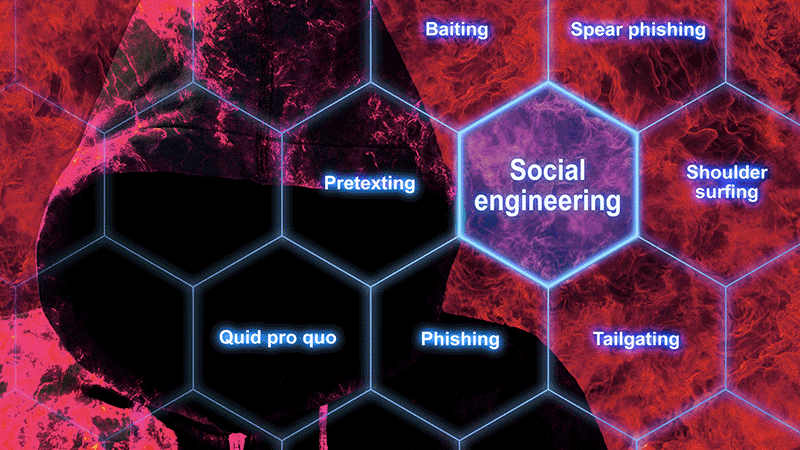To protect your company and brand from potential breaches (often called phishing attacks), social engineering prevention is required. While unethical practices aim to steal information that could permanently damage your company, we identify every vulnerability to prevent network security harm.
Secure the integrity of your business from social engineering attacks with comprehensive phishing, spear phishing, and social engineering attack protection.

Protect Your Business
When an attack happens to your company, it feels like no one’s information is safe from prying eyes. No matter how locked up you might think your cyber security policies and procedures are, the fact of the matter is that social engineering attacks can happen at any time. Hackers can burrow into your company’s data where you least expect it, often through vulnerabilities found in your network systems and employee best practices.
62% of businesses have experienced a social engineering attack at some point in time. While the specifics may vary on how the types of social engineering attacks occur, it’s always a wake-up call to organizations with more lax data rules. These kind of attacks are becoming increasingly more sophisticated and common among enterprise companies and SMBs alike. With every new security software put into place, there are a dozen hackers out there preparing to take it down.
With these attacks tricking employees and other individuals into sharing valuable company data, credentials, or other confidential information, it’s imperative that businesses keep up with cyber security standards in order to stay safe.
While anti-phishing technology and other forms of phishing protection are doing their part, social engineering attacks will always involve a human element. For this reason, providing security against social engineering attacks can be laborious and complicated for companies. We offer comprehensive protection and defense against social engineering attacks to help enterprises and SMBs protect important business systems, customer data, and employee information.
What's the Difference Between a Phishing Attack and Social Engineering Attack?
A social engineering attack is used to define a broad spectrum of hacking activities that are accomplished through real (actual or perceived) human interaction. There are varying types that all use manipulation in order to pry information from customers or end users. This kind of digital trickery is all too commonplace, leading to a wave of identity and other types of data theft.
Have you ever been called on the phone by someone claiming to be from your bank of choice, requesting updated social security information or account details? A common attack scenario involves a perpetrator gathering background information on a company or person’s weaknesses before moving forward. Once trust is gained, it’s only a matter of time before a hacker attempts to reveal more sensitive or resource-critical information.
A phishing attack is a type of social engineering attack that falls within the same family of security breaches - in fact, it is the most common form. Mostly used to fraudulently collect private data, this type of attack directs you to click on a link (usually within a message) that will unleash malicious software and viruses onto the computer in use. In many cases, the software is so sophisticated that it can steal user credentials and other key information in mere seconds.
With spear phishing, the hacker will target specific employees at a company with a personalized message that seems legitimate. When an employee responds or interacts with the email in question, the hacker obtains immediate access to the computer to steal data and install malware.

Types of Social Engineering Attacks
The most important factor to consider in social engineering attacks is that it needs human curiosity and direct action in order to thrive. With this type of psychology-focused hack, enterprises and SMBs need to be particularly careful with how employees handle information. There are many types of attacks to be aware of, but five specific cyber attack types happen more often than not.
Pretexting
In pretexting, the hacker focuses on developing a thorough and believable pretext (or, false scenario) that can be used to try and steal information. The perpetrator pretends to be someone else in an official capacity needing bits and pieces of key data, often in order to “confirm an identity.” For a company employee, this simple sense of urgency can be all it takes to share personal information.
Advanced pretexting attacks will try to convince the individual to perform a specific action that gets the hacker into another entry point. Being able to identify a company’s weak points are a pretext hacker’s specialty; they will even go as far as impersonating a third-party IT service in order to gain access to the company building or database.
Baiting
Similar to a phishing attack, baiting is a method that uses an offering of some kind to entice the targeted individual. Generally, this form of attack is done online using free movie downloads or exclusive video access as the bait of choice. When the link or fake ad is clicked on, malware and malicious programs are released on an unsuspecting computer.
Quid Pro Quo
Much like the baiting methods used, quid pro quo attacks promise something of value in exchange for sharing information. In this case, the benefit being offered is usually a service rather than a good. For this type of attack, imposters pose as IT service people and security experts who spam companies with information about their services. By promising quick fixes and amazing results, these frauds trick businesses into clicking through fake website links and other malicious urls to learn more, disabling key programs, and installing malware onto department computers.
Tailgating
Another type of social engineering attack is known as tailgating. These cyber attacks involve someone without credentials following an employee into a restricted area, often in the form of a delivery driver, to get access to a building. Once gaining security approval by “piggybacking” inside, the attacker will pretend to keep of the facade in order to get past the front desk or reception area. As an in-person violation, tailgating is the most up-front way that someone can hack into your systems or acquire any other sensitive information.
Scareware
Scareware is an attack that preys on an employee’s natural fear using false alarms and threats. With a simple notice that their system could be infected with malware, a targeted individual’s reaction is usually first to attempt to fix the issue. In this case, installing the recommended anti-phishing tools actually leads to an installation of malware itself. Often referred to as deception software, scareware is distributed by spam email, browser pop-ups, and fake ads.
The human element will always be a factor where key information is concerned, but there are certain steps that you can take to make your business more secure with powerful protection. Here are some of the things you can do to secure your company against hackers employing social engineering techniques.
 How to Protect Yourself From Phishing Scams
How to Protect Yourself From Phishing Scams
All businesses and the employees that operate them are subject to be victimized by phishing attacks. With these social engineering attacks on the rise, many enterprises and SMBs are wondering, how can you protect yourself from phishing email scams?
Our IT security consultants are experts when it comes to protection, and will build a completely customized plan of defense that includes all of the most powerful anti-phishing technology and apps, as well as other anti-phishing tools. In terms of more general tips for employees and department heads, here are some of the most important things to do to avoid social engineering attacks:
- Increase employee security awareness by providing training on the common forms of cyber attack and how to detect them.
- Never open emails from untrusted sources.
- Watch out for questions or offers with a questionable pretext.
- Don’t entertain special and “too-good-to-be-true” offers from strangers.
- Lock your laptop whenever you are away from your workstation.
- Require mandatory security software and antivirus protection.
- Be wary of strangers attempting to enter the building or parking lot - always ask for identification.
- Perform regular security checks on company computers, network systems, and other tech.
